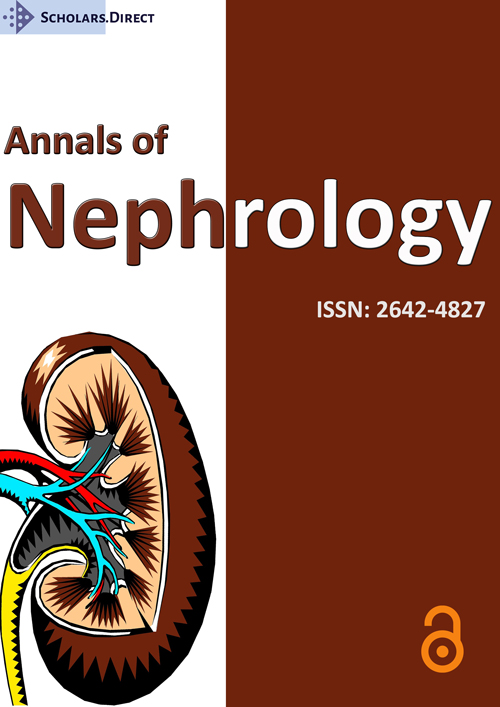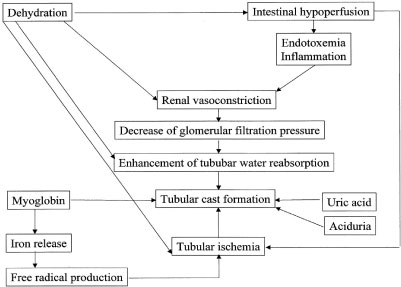An Unusual Cause of Rhabdomyolysis with Acute Kidney Injury
Abstract
Rhabdomyolysis is a serious syndrome due to a direct or indirect muscle injury. It results from the death of muscle fibers and release of their contents into the bloodstream. It can result from a variety of etiologies which may include traumatic or non-traumatic causes. Rhabdomyolysis due to hanging is extremely uncommon and not described in literature. This case highlights rhabdomyolysis as a potential complication of hanging.
Keywords
Rhabdomyolysis, Hanging, Acute kidney injury, Hemodialysis
Introduction
Rhabdomyolysis is a serious syndrome due to a direct or indirect muscle injury. It results from the death of muscle fibers and release of their contents into the bloodstream. It can result from a variety of etiologies which may include traumatic or non-traumatic causes. In the first category, causes may include crush injury such as from an auto accident, fall, or building collapse, long-lasting muscle compression such as that caused by prolonged immobilization after a fall or lying unconscious on a hard surface during illness or while under the influence of alcohol or medication. The non-traumatic causes of rhabdomyolysis include the use of alcohol or illegal drugs such as heroin, cocaine or amphetamines, extreme muscle strain, especially in someone who is an untrained athlete, the use of medications such as antipsychotics or statins, especially when given in high doses, very high body temperature (hyperthermia) or heat stroke, seizures or delirium tremens, metabolic disorder such as diabetic ketoacidosis, diseases of the muscles (myopathy) such as congenital muscle enzyme deficiency or Duchenne's muscular dystrophy, viral infections such as the flu, HIV, or herpes simplex virus and very rarely sepsis. Regardless of the cause, widespread disintegration of the muscle tissue results in the release of ions and molecules that are part of the intracellular compartment to be released into the blood stream. Rhabdomyolysis due to hanging is extremely uncommon and not described in literature. This case highlights rhabdomyolysis as a potential complication of hanging.
Case Presentation
A 22-year-old student with a history of emotional disturbance was found by his parents hanging from a ceiling fan with a rope at his home. He also had a history of increased alcohol consumption for a few months before this episode. Upon noticing, he was immediately brought down and got to our hospital and it was unclear for how long he had been suspended. There was no history of seizures at any time. At the time of presentation, he was comatose with Glasgow Coma Scale of 9/15, general physical examination showed bradycardia (HR 57 beats/min) with a normal systemic pressure. A brownish ligature of about 0.5-1 cm thick mark was visible throughout the circumference of his neck. Anteriorly it was noticed just below the thyroid cartilage. Neurological examination revealed bilaterally equal and reactive pupils, generalized hypotonia, sluggish deep tendon reflexes, bilateral flexor plantars, and hoarseness of voice. Other systems were normal.
Investigations
Routine laboratory tests at the time of admission showed hemoglobin 16.8 gm/dl, total leucocyte count of 27400/cmm, Platelet count 314000/cmm, Urea 55 mg/dl, Serum Creatinine 3.32 mg/dl, serum creatinine phosphokinase of 75282 IU/L, serum sodium 147 mEq/L, Potassium 3.51 mEq/L, Calcium 8.9 mg/dl, Phosphorus 7.8 mg/dl. A plain CT and MRI of head and cervical spine were done which was found to be normal. The patient was admitted to the intensive care unit, diagnosed to have hypoxic ischaemic encephalopathy secondary to hanging and was treated conservatively with intravenous fluids and the application of a hard cervical collar. The patient responded to this therapy and his sensorium improved steadily. Despite maintaining a good urine output, serial renal function tests deteriorated, with serum levels of urea being 124.9 and creatinine as 6.03, peaking respectively, and CPK levels being 88201. Liver function tests revealed AST of 203 IU/L and AST of 64 IU/L and patient was diagnosed to have Acute Kidney Injury probably due to Rhabdomyolysis secondary to hypoxia. The patient has been treated with intravenous fluid initially and Hemodialysis and was also evaluated for drug toxicity including a screening drug panel for barbiturates, opioids and alcohol and results were negative. We did not have facilities for assessment of other offending drugs. The patient regained full consciousness in the hospital after 24 hours and continued to have fluctuating urine output and received a total of 6 sessions of Hemodialysis in which the functions of kidney showed a gradual recovery and could be taken off dialysis. And then the patient has been discharged from the hospital with a serum creatinine of 1.7 mg/dl. At present the patient continues to be on regular check-up and has been undergone for evaluation of any psychological issues by the psychiatry team with appropriate counseling.
Discussion
Hypoxia is well recognized cause of rhabdomyolysis and prolonged failure of oxygenation can result in widespread muscle fiber dissolution resulting in rhabdomyolysis. This has been reported in varied conditions that cause hypoxia such as near drowning [1] status asthmaticus [2], carbon monoxide poisoning [3] etc. While the exact mechanism of rhabdomyolysis in hanging is unclear, it is presumed that a state of hypoxia and the rigid posturing may lead to muscle breakdown. Our patient did not have any noticeable seizures and had not suffered a cardiac arrest, though we cannot exclude seizures as a possible cause of rhabdomyolysis. Levels of serum creatinine phosphokinase were more than 10 times the upper limit and this has been often used a marker of the severity of muscle injury [4]. Urinary myoglobin is an unreliable marker due to the fact that it is rapidly cleared by hepatic metabolism [5].
Acute renal failure is the most common cause of rhabdomyolysis and occurs in up to 33% of patients [6]. The pathophysiology of kidney injury is depicted in Figure 1. Crush injury with rhabdomyolysis has been described in detail by Viswevaran, et al. [6]. Once rhabdomyolysis has set in, then treatment is directed towards preventing the precipitation of myoglobin within the renal tubules and maintaining an adequate urine output of 150-300 ml/hr [7], alkalinisation of urine [8] to a pH beyond 6.5 to prevent dissociation of ferrihemate moiety responsible for free radical generation and use of mannitol and loop diuretics judiciously [9]. Use of large volumes of fluid as an effective preventive measure was documented in the crush induced rhabdomyolysis in the 2000 Marmara earthquake [10].
Hanging as a cause of rhabdomyolysis in a survivor is so uncommonly reported and we could find only one other similar case in medical literature [10]. Reverse hanging (also called Palestinian hanging) has been reported to be cause though this is more used as a torture technique [11]. We report this case to bring to light a very rare cause of rhabdomyolysis so that treating physicians can be aware that rhabdomyolysis can be seen as a delayed manifestation of hypoxia.
Conflict of Interest
Nil.
Financial Disclosures
Nil.
References
- Ricardo B, Mohammed S, Tejinder SA (1999) Rhabdomyolysis associated with near-drowning. Am J Med Sci 318: 201-202.
- Li AM, Li CC, Chik KW et al. (2001) Rhabdomyolysis following status asthmaticus. J Paeditar Child health 37: 409-410.
- Sungur M, Guven M (1997) Rhabdomyolysis and suicidal hydrocarbon inhalation. Ann Emerg Med 29: 301-302.
- Russell TA (2005) Acute renal failure related to rhabdomyolysis: Pathophysiology, diagnosis and collaborative management. Nephrol Nurs J 32: 409-417.
- Rodriquez-Capote K, Balion CM, Hill SA, et al. (2009) Utility of urine myoglobin for the prediction of acute renal failure in patients with suspected Rhabdomyolysis: A systematic review. Clin Chem 55: 2190-2197.
- Visweswaran P, Guntupalli J (1999) Rhabdomyolysis. Crit Care Clin 15: 415-428.
- Abassi ZA, Hoffman A, Better OS (1998) Acute renal failure complicating muscle crush injury. Semin Nephrol 18: 558-565.
- Malik GH (1998) Rhabdomyolysis and Myoglobin-induced Acute Renal failure. Saudi J Kidney Dis Transpl 9: 273-284.
- Vanholder R, Sukru Sever M, Erek E, et al. (2000) Rhabdomyolysis. J Am Soc Nephrol 11: 1553-1561.
- Naha K, Saravu K, Ramachandran B (2011) Rhabdomyolysis with acute kidney injury in a case of hanging. BMJ Case Rep 2011.
- Pollanen MS (2016) Fatal rhabdomyolysis after torture by reverse hanging. Forensic Sci Med Pathol 12: 170-173.
Corresponding Author
Dr. Shobhana Nayak Rao, Associate Prof and Head, Department of Nephrology, K.S. Hegde Medical Academy, Medical Sciences Complex, Derlakatte, Mangalore 575018, Karnataka, India, Tel: +91-824-2204471-76 (Ext : 2347), Fax: +91-824-2204016.
Copyright
© 2019 Gharge A, et al. This is an open-access article distributed under the terms of the Creative Commons Attribution License, which permits unrestricted use, distribution, and reproduction in any medium, provided the original author and source are credited.





